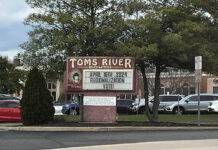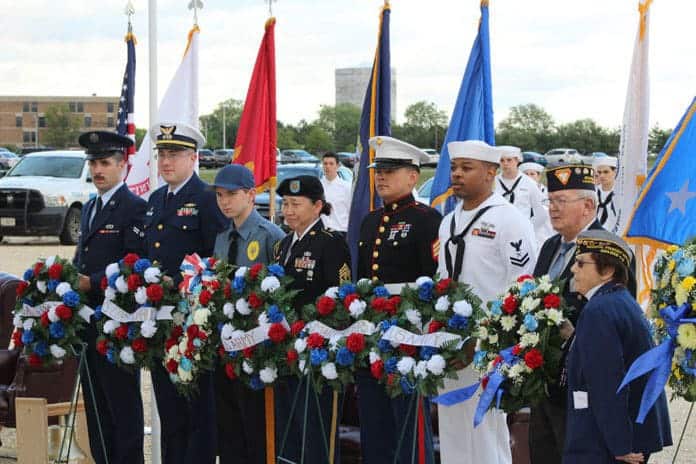
LAKEHURST – It happened 80 years ago but it remains a point of local fascination and is seen by many as a turning point in aeronautical engineering. It put the borough of Lakehurst and Ocean County on the global map. Several hundred people came out to remember the event which took the lives of 36 people involved with the final flight of the DLZ-129 Hindenburg.
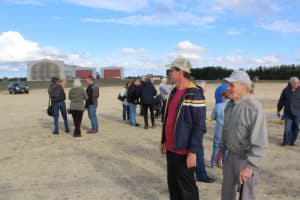
Military personnel, public officials, historians and those simply curious came out on the evening of May 6 to the grounds of the Lakehurst Naval Air Station where the explosion and crash occurred eight decades ago. A ceremony was held in partnership between the Joint Base McGuire-Dix-Lakehurst and the Navy Lakehurst Historical Society.
For 90-year-old Henry Stuetzel, it was an important event to observe. His son Walter drove him to the event from his Maplewood home. “I’m from Germany and it is quite an event of history. I was 11 years old when it happened. I remember when it took off. I lived in Stuttgart, Germany and I was born around the time when the zeppelin was being built.”

The full account and chronology of what occurred was touched upon by the various speakers at the event. Among the speakers were Navy Lakehurst Historical Society President Carl Jablonski, who read the names of those lost at the close of the ceremony; Col. Frederick Thaden, commander, Joint Base McGuire-Dix-Lakehurst; Dr. Horst Schirmer, whose father designed the aeronautics for the Hindenburg; Ocean County Freeholder Virginia E. “Ginny” Haines; and Lt. Gen. Gina M. Grosso; U.S. Air Force Deputy Chief of Staff for Manpower, Personnel and Services, Headquarters.

The German Zeppelin flew one year of transatlantic service from 1936 to 1937 and had a length of 804 feet, standing 146 feet tall and had a speed capability of more than 80 miles per hour. It could cross the ocean with as many as 70 passengers and 10,000 pounds of express freight. The zeppelin served as a symbol of propaganda for Adolph Hitler’s Nazi Germany. On the evening of May 6, 1937 the Hindenburg approached Lakehurst 12 hours late as a large crowd gathered to greet her. At 7:15 p.m. as radio announcer Herb Morrison described the airship landing it burst into flame as it attempted to dock. Nearly 100 people were on board including 36 passengers and 61 crewmen, of those 13 passengers and 22 crewmen died. One worker on the ground was also killed, raising the final death toll to 36.
Retired school teacher and historian David Helms traveled from Munroe, North Carolina to attend a Friday night banquet in Toms River that noted the 80th anniversary of the tragedy as well as the May 6 ceremony.
“This is my third total trip to the crash site. I came here in 1994, 1998 and I am here today. I am an avid researcher, especially anything involving the military,” Helms said while watching Hanger Number 1 where the Hindenburg was once housed.
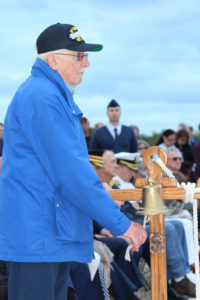
“Being here tonight at the crash site still sends chills down to my spine,” Helms said. He said his research included receiving a letter from one the crash crew and that he had interviewed Ann Springs Close, who at the age of 10, flew on the Hindenburg in 1936.
Helms also said that while in route to Lakehurst the captain of the Hindenburg had been told kill time and fly around New York City. “There was a ball game going on that day between the Pirates and the Brooklyn Dodgers. Van Lingel Mungo who was from South Carolina 25 miles from where I live. He was pitching for the Dodgers. They stopped the game so everyone could see the Hindenburg could fly over head. No one knew that it would blow up hours later.”
“It is a surreal feeling being here today, ” Col. Thaden said. “Along with the tragedy and loss of life we recognize those who survived and those who responded.”
Freeholder Haines noted that fellow Freeholder and history buff John C. Bartlett had recently remarked during a World War I remembrance service that the Hindenburg disaster was perhaps the most noted historical event that Ocean County had experienced. Haines added that the Joint Base remains “a very important facility for our country.”
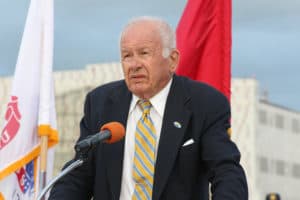
Schirmer recounted zeppelin history which began with Count Ferdinand von Zeppelin, who was born in 1838 and was a German aircraft manufacturer, who founded the Zeppelin airship company. He also spoke of the difficulties early airships had with using a lead ball balance system that was later replaced by gas bags that could be vented to maintain balance.
“There were 112 dirigibles built in World War I to use in war. The Hindenburg was so large it barely fit in the hanger here,” he said. “My father was engaged in physics and all the aeronautics in the construction of the Hindenburg. I was taken aboard as a little boy by my father.”
“The U.S. had a lot of helium, which is non-flammable, in Arkansas and Texas. Hydrogen was flammable but inexpensive but helium was expensive. The U.S. could not sell helium to Germany as Germany had attacked the U.K. in World War I. FDR could not change the rule of congress to sell helium to Germany. So, the Hindenburg flew with hydrogen. It flew with passengers for the first time in 1936,” Schirmer said.
Amidst concerns of sabotage and the airship being used as Nazi propaganda tool and bad weather conditions, Schirmer said that the large airship came in at a very slow speed and that a combination of factors concerning the venting system most likely caused the hydrogen to ignite.
“We will never know what happened. Hopefully there was no sabotage. Despite what happened the Hindenburg left us with a good view of these flights. It was a fabulous machine.”






